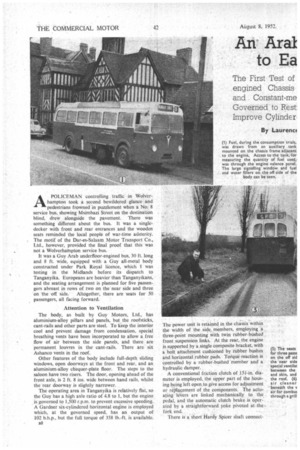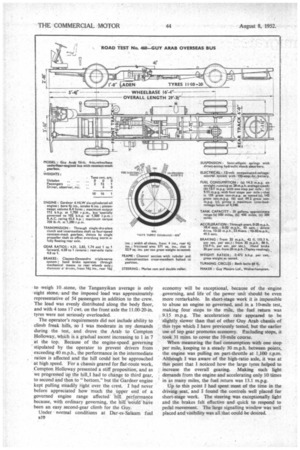An: Aral to Ea migrates kfrica
Page 42

Page 43

Page 44

Page 45

If you've noticed an error in this article please click here to report it so we can fix it.
By Laurencf ton, M.I.R.T.E.
APOLICEMAN controlling traffic in Wolverhampton took a second bewildered glance and pedestrians frowned in puzzlement when a No; 8 service bus, showing Msimbazi Street on the destination blind, drew alongside the pavement. There was something different about the bus. It was a singledecker with front and rear entrances and the wooden seats reminded the local people of war-time atisterity. The motif of the Dar-es-Salaam Motor Transport Co., Ltd., however, provided the final proof that this was not a Wolverhampton service bus.
It was a Guy Arab underfloor-engined bus, 30 ft. long and 8 ft. wide, equipped with a Guy all-metal body constructed under Park Royal licence, which I was testing in the Midlands before its dispatch to Tanganyika. Europeans are heavier than Tanganyikans, and the seating arrangement is planned for five passengers abreast in rows of two on the near side and three
on the off side. Altogether, there are seats for 50 passengers, all facing forward.
Attention to Ventilation
The body, as built by Guy Motors, Ltd., has aluminium-alloy pillars and panels, but the roofsticks, cant-rails and other parts are steel. To keep the interior cool and prevent damage from condensation, special breathing vents have been incorporated to allow a free flow of air between the side panels, and there are permanent louvres in the cant-rails. There are silt Ashanco vents in the roof.
Other features of the body include full-depth sliding windows, open doorways at the front and rear, and an aluminium-alloy chequer-plate floor. The steps to the saloon have two risers. The door, opening ahead of the front axle, is 2 ft. 8 ins, wide between hand rails, whilst the rear doorway is slightly narrower. .
The operating area in Tanganyika is relatively flat, so the Guy has a high axle ratio of 4.8 to 1, but the engine . is governed to 1,500 r.p.m. to prevent excessive speeding. A Gardner six-cylindered horizontal engine is employed which, at the governed speed, has an output of 102 b.h.p., but the full torque of 358 lb.-ft. is available.
s8
The power unit is retained in the chassis within the width of the side_ members, employing a three-point mounting with twin rubber-bushed front suspension links. At the rear, the engine is supported by a single Composite bracket, with a bolt attachment cushioned by rubber bushes and horizontal rubber pads. Torque. reaction is controlled by a rubber-bushed member and' a hydraulic damper..
A conventional friction clutch of 151-in, diameter is employed, the Upper part of the housing being left open, to give access for adjustment or replacement of the components. •The actuating levers are linked mechanically to the pedal, and the automatic clutch brake is operated by a straightforward yoke pivoted at .the fork end.
There is a short Hardy Spicer shaft connect
ing the clutch and independently mounted constant-mesh gearbox, which is supported between two tubular crossmembers. One of the major difficulties in underfloorermined vehicle design is to provide light action of the gear lever, because the linkage between the lever. at the front of the chassis and the gearbox amidships
normally requires two or more bearing& .
In the Guy chassis the lever is connected to the gearbox through a cross-shaft at the front,-which is carried on ." frictionless 7 bearings permitting axial. and rotary movement of the shaft, and i three-piece tube:linked by universal joints and supported in the . frame by two bearings of a similar pattern. The bearings are sealed and all sliding parts of the linkage have rubber-bellows dirt excluders. I found nothing to criticize in the effort required to move the gear lever when testing thevehicle..
*Triple-servo Braking .
Unlike most overseas users, the Dar-es-Salaam operator specified a triple-servo braking system, .Clayton Dewandre equipment being employed, with the rotary exhauster mounted inside the frame and driven from the gearbox front coupling. Another component driven from the gearbox coupling is the dynamo.
The load for the trials comprised 4-cwt. iron weights, resting on sacks between the seats and secured against fore-and-aft movement by wooden cross-bearers. Having regard to the al-metal construction of the body, the timber slatted seats and the type of payload, I expected to find considerable noise. reflection. I was,however, favourably impressed by engine-insulating arrangements and general quietness of the body., Although in this country each passenger is estimated • to .weigh 10...stone, the Tanganyikan average is only eight stone, and the imposed load was approximately. representative of 54 passengers in addition to the crew. The load was evenly distributed along the body floor, and with 4 tons 17 cwt. on the front axle the 11.00-20-in. tyres were not seriously overloaded.
The operator's requirements did not include ability to climb freak hills, so I was Moderate in my demands during the test, and drove the Arab to Compton Holloway, which is a gradual ascent increasing to 1 in 7 at the top. Because of the engine-speed governing stipulated by the operator to prevent drivers from exceeding 40 m.p.h., the performance in the intermediate ratios is affected and the hill could not be approached at high speed. For a chassis geared for flat-route work, _Compton Holloway presented a stiff proposition, and as we progressed up the hilI,I had to change to third gear, to second and then to "'bottom," but the Gardner engine kept pulling steadily right over the crest. I had never before appreciated how much the upper end of a governed engine range affected' hill performante because, with ordinary governing, the hill would'have been an easy .second-gear climb for the Guy.
Under normal conditions at Dar-es-Salaam fuel al 0
economy will be exceptional, because of the engine . governing, and life of the power unit should be even more rernarkable. In short-stage work it is impossible to abuse an engine so governed, and in a 10,mile test, making four stops to the mile, the fuel return was 9.15 m.p.g. The acceleration rate appeared to be slightly slower than that of other Guy Arab chassis of this type which I have previously tested, but the earlier use of top gear promotes economy. Excluding stops, it took 31 mins. to cover the 10-mile course.
When measuring the fuel consumption with one stop per mile, keeping to a steady 30 m.p.h. between points, the engine was pulling on part-throttle at 1,100 r.p.m. Although I was aware of the high-ratio axle, it was at this point that I noticed how the large tyres helped to increase the overall gearing. Making such light demands from the engine and accelerating only 10 times in as many miles, the fuel return was 13.1 m.p.g.
Up to this point I had spent most of the time in the driving seat, and I found the controls well placed for short-stage work. The steering was exceptionally light and the brakes felt effective and quick to. respond to pedal movement. The large signalling window was well placed and visibility was all that could be desired.
I relinquished the controls to observe the acceleration and braking performance, using a Webley air pistol to measure the stopping distance. The rear wheels locked on every emergency application. At 20 m.p.h., tyre marks were visible on the road for over 20 ft. of the measured stopping distance, and at 30 m.p.h. the bus skidded for 75 per cent. of the braking distance. As there was no more suitable ground for testing retardation, 1 had to be content with stopping distances which did not give an accurate record of the braking performance. As before when I tested an Arab underlloor-engined model, the hand brake was found to be particularly effective, the Tapley readings being 29-30 per cent The relatively short governed range of the engine necessitated early gear changes and the acceleration rate was affected accordingly. Using second, third and fourth gears 4 20 m.p.h. was reached from a standing start in 18.4 secs. and 30 m.p.h. was attained in 43 secs. Again the high overall gear ratio was apparent in topgear acceleration, for 49.5 secs, were required to reach 30 m.p.h. from a rolling start.
The gear ratios, engine governed speed and large tyres are well selected for the operating conditions, and the special measures taken to combat wear and climatic conditions should result in exceptional vehicle life. The all-metal body is a wise choice for use in an area where timber is susceptible to attack by insects, and the replacement of any damaged metal part is a task which can -be undertaken by semi-skilled labour.




















































































